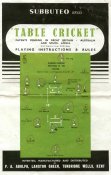
| Peter Upton's |
Subbuteo Tribute Website. |
|
Playing Instructions and Rules. |
|
1950s Cricket Rules. |
Rugby Rules: 1950s; 1960s-80s. Cricket Rules: 1950s (this page); 1960s-1980s
Subbuteo Cricket - Page 1: Box Sets, Page 2: Accessories
Subbuteo Rugby - Page1: Box Sets, Page 2: Accessories, Page 3: Teams
Subbuteo Football boxed editions
There are two distinct versions of Subbuteo cricket, the flat version of the 1950s and the later OO scale version which was produced in the late 1960s. The flat version arrives very early in Subbuteo's history, possibly before 1950, and is another absolute classic in terms of gameplay. Like the football (but unlike rugby), Peter Adolph has a great set of rules and playing mechanism worked out from the start, and the OO scale cricket produced in the 1960s-80s does not vary all that much from this original form. Indeed, the flat bowler is retained for this later set, as are the wicket stops (which represent the amount of ground a wicket keeper would cover).
What is different in the 1950s game is fielding. Here the fielders are on the standard football bases of the period rather than being on catching bases. So in this version, a catch occurs when the ball rests close to the base (or hits the special "catching" fielder). Runs are determined by the number of flicks used to return the ball to the wicket stop (i.e. keeper), which gives an extra degree of skill to fielding not found on the later version (and also gives the game a further tie-in to the football version).
The Early Cricket Rules.

Introduction.
When you commence to play with SUBBUTEO "Table
Cricket" you will be able to reproduce the skill, tactical thinking and
excitement of Test and County Cricket.
Particular attention should be given to the instructions under "Method of
Play", as the amount of skill that you will put into the game will largely
depend on how you control the various apparatus.
Playing Pitch.
Place a smooth but thick cloth on a table and chalk out a design to the dimensions printed on the frontpiece coloured chart, vis. :-
Outfield boundary lines, 48in. x 32 in.
Distance between wickets, 16in.
Bowling crease, 5in, long
Popping crease, 5 in. long and 2 in. in front of bowling crease.
Placing the Field.
Stand three stumps on the pieces of green celluloid which
should be placed in the middle of each of the bowling creases, and rest the
bails across the top of each wicket. Place a 5in. long celluloid wicket stop
3in. behind each wicket.
The fielding side figures are placed on the field, with the bowler behind one
wicket, and the wicket-keeper behind the stumps at the other end. The two
batsmen are placed in their respective creases, and the umpire figures also take
up their stands in the normal positions.
The red base carrying the representation of a cricket bat should be kept within
handy reach.
Method of Play.
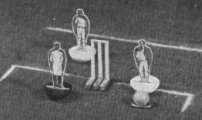

BOWLING. - The ball is placed on the wire holder carried by the bowler's base (photograph 1), and the back of the figure is flicked with either the first or second finger, as is found to be more convenient in order to deliver the ball over the top of the figure and in the direction of the batsman's wicket (photograph2). Do not use the thumb as a spring: the thumb does not enter into the delivery. The strength and speed of the flick will control the speed of delivery of the ball, so as to represent fast and slow bowling, and the setting of the wire holder in either a flat position or tending either to right or left before delivery will also assist in varying the actual type of ball bowled.
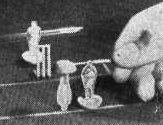
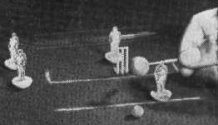
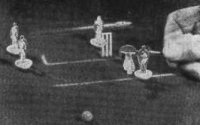
BATTING. - The wire handle, which is attached to the red base
carrying the bat, is held above the surface of the playing pitch with the bottom
of the bat resting on the playing pitch and with the outstanding wire handle
behind the actual batsman figure (see photograph 3).
The bat is operated by rotating the wire handle between the thumb and first
finger in an imitation of a batting stroke whilst the ball is being delivered by
the bowler in order to try and hit the ball in a desired direction (photographs
4 and 5). Leg strokes, off drives, cuts, and all the other strokes of real
cricket may be reproduced with practise.
The photographs (shown above) depict a right-handed batsman's stance (or forehand rotation movement), but it is, of course, quite in order to take up a left-handed batsman's stance (or backhand rotation movement).
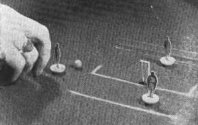
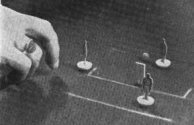
FIELDING. - Any of the fielding figures may return the ball to one of the wicket stops by the following procedure. Place the first finger of the right hand or the second finger if this feels more comfortable) immediately behind the base of a figure, with the tip of the nail just touching the table (photograph 6). Use the table as a spring, and gently flick the base against the ball (photograph 7).
Play.
A coin is tossed for the preference of batting or fielding. Agreement should be reached as to whether the match shall be of a single or double innings. Each over should be of six balls, and "ends" changed at the opening of a new over.
Rules of Play.
(Play to the Rules of Cricket in conjunction with the under mentioned.)
A batsman is :-
Bowled - when the ball touches the wicket even if the bails are not removed.
Caught - when the ball rests within half an inch from the base of a fieldsman, or touches the single fielding player's base which is drawn depicting a ball being caught.
L.B.W. - when the batting figure (in either a red or blue bordered sweater) obstructs the delivery of the ball to the wicket. If the ball hits any part of this figure when it is not obstructing the wicket, any score made is considered to be a leg bye.
Stumped - when the batting figure is drawn out of the crease, and the bal rebounds from the wicket-keeper figure onto the stumps.
Run out - when a fielding figure hits the wicket with the ball with any batting figure outside of his crease, or, when a ball is hit to within two inches of the boundary line when a fielding figure is allowed to aim the ball straight at the wicket, irrespective of whether the batsman figure is within his crease or not.
Scoring.
Runs are scored by direct hits to the boundary lines. Four runs when the ball is hit along the surface, and six runs when the ball is hit over the playing surface.
Other runs are scored by dividing by half the number of flicks a fieldsman takes to return the ball to a wicket stop. If a fieldsman returns an odd number of flicks to return the ball to a wicket stop, the odd number is ignored and the even number before it only taken into account. Example: 5 flicks is considered 4, which divided by half equals 2 runs. (Technically, if you divide 4 by half, you'd get 8. So this should read divide in half, or maybe divide by 2).
If a batsman in a red bordered sweater us at the receiving end of the wicket when an odd number of runs is scored, the figure in the blue bordered sweater is put automatically in his place.
In order to obtain the lower scores of the tail-end, you may consider the last three batsmen to be caught if they play the ball against the base of any fielder.
Rugby Rules: 1950s; 1960s-80s. Cricket Rules: 1950s (this page); 1960s-1980s
Subbuteo Cricket - Page 1: Box Sets, Page 2: Accessories
Subbuteo Rugby - Page1: Box Sets, Page 2: Accessories, Page 3: Teams
Subbuteo Football boxed editions
[ Main Page | Previous Page | Next Page ]